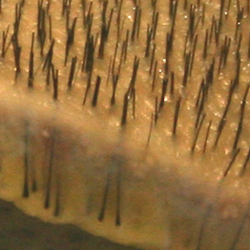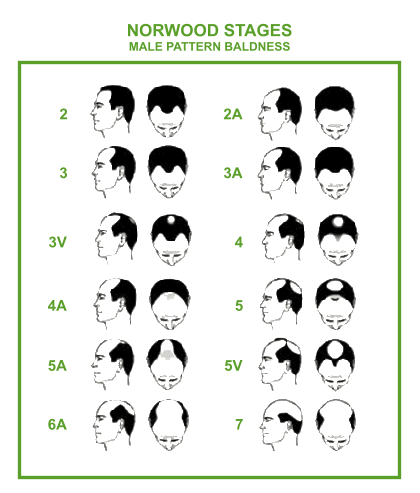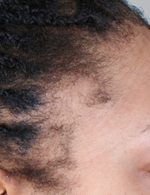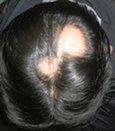About Hair & Hair Loss
Essential Hair Facts
 For each of our 100,000 scalp hairs there is a follicle under the skin that makes it grow. On the surface of the skin you can see separate clusters of 1 to 3 or more growing hairs. The corresponding hair follicles below the skin are also bound together in clusters called “Follicular Units”. Using naturally-occurring follicular units as the basic building blocks for hair transplantation (with skilled artistry and advanced techniques) allows modern hair transplants to look virtually undetectable.
For each of our 100,000 scalp hairs there is a follicle under the skin that makes it grow. On the surface of the skin you can see separate clusters of 1 to 3 or more growing hairs. The corresponding hair follicles below the skin are also bound together in clusters called “Follicular Units”. Using naturally-occurring follicular units as the basic building blocks for hair transplantation (with skilled artistry and advanced techniques) allows modern hair transplants to look virtually undetectable.
Hair follicles are like factories. Factories can go through manufacturing, retooling, and shut-down phases. Hair follicles go through growing (Anagen), transition (Catagen), and resting (Telogen) phases.

 Follicles typically grow hairs for 2 to 6 years then rest for 2 to 4 months before producing a new hair. New hairs push out the old hairs that had stopped growing.
Follicles typically grow hairs for 2 to 6 years then rest for 2 to 4 months before producing a new hair. New hairs push out the old hairs that had stopped growing.
On any given day, 85-90% of hair follicles are growing, 10-15% are resting, and 100 hairs are shed as 100 new hairs start growing. Transplanted hair follicles typically go through a resting phase before they start to grow new hairs.
What Causes Hair Loss?
An experienced physician should diagnose the cause of your hair loss before you consider any treatment.
Androgenetic Alopecia (AGA) can affect up to 50% of men and 40% of women by the age of 50. AGA can be inherited from either or both sides of your family. It does not affect every family member equally, however.
The hair follicles on the sides and back of your head are usually immune to this condition but the hair follicles on top are sensitive to normal amounts of the androgen/hormone called Dihydrotestosterone or DHT. Over the years the affected follicles grow hairs for shorter and shorter times.
The hairs they produce become finer, lighter in colour, and shorter. They gradually shrink before your eyes and go from being strong, healthy hairs to peach fuzz to being so small they are invisible to the human eye. Medications can slow hair loss and a hair transplant can replace the lost hair with long-lasting hair that is immune to the effects of DHT.
Well over 95% of hair loss sufferers have genetic hair loss called Androgenetic Alopecia (AGA). AGA is more commonly called male pattern or female pattern baldness. Fortunately, hair transplantation with or without additional medical treatment can be very effective for men and women with Androgenetic Alopecia.
Norwood Stages of Male Pattern Baldness
It is important to remember that, over years, hair loss can progress through these stages.

Ludwig Stages of Female Pattern Baldness
It is important to remember that, over years, hair loss can progress through these stages.

Signs that you may not just have AGA include: sudden or rapid hair loss, excessive hair shedding, patchy hair loss, unusual patterns, loss of hair in normally safe areas, broken hairs, red or painful scalp, shiny or scarred scalp, and scalp rashes or infections.
Some other causes of hair loss that can be treated by hair transplantation include: Traction Alopecia from chronic pulling on hair roots, Traumatic Alopecia from injuries, chemicals, or burns, Surgical Alopecia, Congenital Alopecia (since birth), and Radiation-induced Alopecia.

Traction alopecia occurs when repeated pulling and tension on hair destroys the follicles. Wearing tight corn rows or braids, fastening heavy hair extensions, using hair clips to fasten wigs or hair systems, twisting hair in topknots under turbans, or repeatedly plucking eyebrows are all types of Traction Alopecia.
The first step in treating Traction Alopecia is to change the hairstyle and stop the pulling. If Traction Alopecia is stopped early, some hair may grow back. Hair transplantation can fill in the missing hair if it doesn’t grow back.
If the whole thickness of skin in an area of the scalp is injured by a physical or chemical burn, by trauma, or by infection, the hair follicles will also be damaged.
There will be hair loss and scarring of the scalp. Hair transplantation may be a good option, keeping in mind that the scarred scalp cannot sustain as many grafts at one time as a completely healthy scalp.
 Hair loss from surgery can be due to traction, trauma, or both. The surgical scars from neurosurgery or scalp surgery can often be revised or transplanted.
Hair loss from surgery can be due to traction, trauma, or both. The surgical scars from neurosurgery or scalp surgery can often be revised or transplanted.
In some surgeries, such as the old way of doing facelifts, there can also be permanent hair loss near the surgical scar that is caused by the stretch on the skin. Hair transplantation can often fill in the scar and the areas of hair loss near the scar.
Some people are born with an area of hair loss in the frontal hairline or temples. Whether the bald patch is triangular or oval shaped it is called Triangular Alopecia. Hair Transplantation at the appropriate age can be a good option for people with Triangular Alopecia.
Radiation can both cause temporary hair loss and permanent hair loss. Any hair that will grow back will usually be growing by 6 months after the radiation.
If there is permanent hair loss there will also be scarring and thinning of the scalp. Hair transplantation can help as long as there is enough donor hair available and the transplanted hair is not placed so close together as to overwhelm the circulation in the scarred area.
It is important to remember that more radiation later could cause permanent loss of the transplanted hair too.
Some other causes of hair loss that shouldn’t be treated by hair transplantation include: Telogen Effluvium (Shedding), Anagen Effluvium, Active Alopecia Areata, Diffuse Unpatterned Alopecia (DUPA), Trichotillomania or compulsive hair pulling, Loose Anagen Syndrome, and Active Primary Scarring Alopecias.
Some major stresses such as surgery, an illness, a change in medication, or delivering a baby can reset the hair growth cycle (described above). The stress will push more hairs than usual into the resting phase. You may not see excessive hair shedding on your brush, comb, sink, or pillow until 1 to 2 months later when the new hairs start pushing out the old ones.
People with pure Androgenetic Alopecia do not have excessive shedding. One way to know if you are experiencing excessive shedding is to collect and count all your shed hairs each day for a week. Losing more than 100 hairs per day is excessive shedding.
Most people get Acute Telogen Effluvium and have a full recovery 6 to 9 months after the major stress. Some people who have AGA and also get Telogen Effluvium will not get a full recovery. A few people go on to develop Chronic Telogen Effluvium with chronic shedding and thinning of hair. Chronic Telogen Effluvium can mimic Female Pattern Hair Loss or diffuse Alopecia Areata (which will be discussed later.)
Hair transplantation should not be done when there is active shedding as the transplanted hair will also be shed. The main treatment for Telogen Effluvium is to try to figure out the underlying cause and fix that. There are too many possible causes of Telogen Effluvium to list them all but some of the more common ones are thyroid disease, starting or stopping birth control pills or other medications, iron-deficiency, recent surgery, and rapid weight loss through low calorie diets.
A severe physical shock, such as chemotherapy for cancer or a sudden severe trauma or illness can cause follicles to suddenly stop growing and the hair to shed within 2 weeks.
This is called Anagen Effluvium or shedding of growing hairs. Once the chemotherapy or physical stress stops, the follicle will rest and then start producing a new hair. After 6 months of recovery the hair will start to look fuller again.

 Alopecia Areata is a common condition that results from the immune system mistakenly attacking its own hair follicles. It is slightly more common in women than men and is more common in people who have other autoimmune diseases like diabetes, a specific type of thyroid disease or pernicious anemia (B12 deficiency.) We really don’t know a lot about why people get Alopecia Areata.
Alopecia Areata is a common condition that results from the immune system mistakenly attacking its own hair follicles. It is slightly more common in women than men and is more common in people who have other autoimmune diseases like diabetes, a specific type of thyroid disease or pernicious anemia (B12 deficiency.) We really don’t know a lot about why people get Alopecia Areata.
Classic Alopecia Areata is the sudden development of a bald circular or oval patch in otherwise thick hair. Most of the time, the hair will grow back within 6 months but there are treatments an experienced physician can offer to speed up the recovery. People who have suffered Alopecia Areata once can have relapses later on.
Rarely, an area of Alopecia Areata stays bald. Transplanted hair in an area of active Alopecia Areata will be destroyed so we usually wait until there has been no change in Alopecia Areata for a year before considering hair transplantation. Even then patients must accept that there is a risk that Alopecia Areata may come back in the same place or another place.
Rarely, Diffuse Alopecia Areata can cause tiny patches of hair loss throughout the scalp and this can resemble Androgenetic Alopecia or Chronic Telogen Effluvium.
Alopecia Areata that causes loss of hair over the whole head is called Alopecia Totalis. When Alopecia Areata causes hair loss over the whole body it is called Alopecia Universalis. Hair transplantation is unfortunately not an option for Alopecia Totalis or Universal.
Diffuse Unpatterned Alopecia (DUPA) is an uncommon variation of Androgenetic Alopecia in which the hair all over the head is sensitive to DHT and there is thinning everywhere.
DUPA affects more women than men but the majority of women with AGA do not have DUPA. DUPA should be suspected if there are miniaturized hairs in the normally safe donor area. Hair transplantation is not an option for DUPA because there is no safe long-lasting donor hair.
Some people who habitually or compulsively pull their hair repeatedly have a condition called Trichotillomania. Affected people feel an overwhelming urge to pull or twist their hair.
They feel greatly stressed when they don’t and immediate relief when they do. However, people who are aware that they have this problem often feel guilty later on and usually won’t admit that they pull their hair.
Trichotillomania is quite difficult but not impossible to treat and often involves both the family doctor and a psychiatrist and/or psychologist. We do not offer hair transplantation until a patient can prove and a family member confirms that they haven’t pulled their hair for at least a year. (Transplanted hair would be lost if continuously pulled or twisted and we do not want our patients to waste their money, their time, or their hair.)
Particularly in fair-haired children, growing hairs may be loose in the follicle and get pulled out with normal combing or brushing. This is called Loose Anagen Syndrome.
This may improve as children grow older. Hair Transplantation is not an option for people with Loose Anagen Syndrome.
Folliculitis Decalvans Dissecting Cellulitis
There are uncommon diseases that cause scarring of the scalp and hair follicles. Lupus can cause scarring alopecia but there are many other causes too.


Scarring shows up as shiny, smooth, usually pale skin but can be difficult to see. Sometimes redness and bumps around hair follicles are signs of inflammation that could later lead to scarring. Hair transplantation is usually not an option for scarring due to disease unless it is a disease that “burns out” and becomes inactive.
If you think that you might have hair loss due to scarring it is best to consult an expert physician for an accurate diagnosis.
Hair Loss Treatment Options
Hair Transplantation
Hair transplantation for appropriate patients is often the best way to improve the appearance of their hair. It is a minor skin surgery that moves long-lasting donor hair follicles from an area where you have more than you need to an area of noticeable hair loss that we call the recipient area.
At the Canadian Hair Transplant Centre, we excel at the art and science of hair transplantation to give you reliable, natural-looking results so you will look your best and feel more confident about your hair.
Non-surgical Hair Loss Treatment Options
Medications
Different approved medications for men and women may be used to slow hair loss and occasionally strengthen enough miniaturized hair to cause improvement. Hair loss treatment medications can be used for those who are not ready for hair transplantation or as supplemental treatment for those who wish to have a hair transplant.
Men may take Finasteride by mouth and/or use topical Minoxidil lotion or foam.
For more about medical treatments for men click here (PDF).
Women can use topical Minoxidil lotion or foam. Other medications would only be helpful for women with elevated androgen levels.
For more about medical treatments for women click here (PDF).
Camouflage
Early hair loss can often be camouflaged by colouring or styling hair differently. When there is less contrast between the colour of the hair and the colour of the scalp, the hair looks less see-through. Curly or wavy hair covers the scalp better than straight hair. The reflected overhead light often makes a centre part look wider than a side part. Styling hair forward or backward may also make the hair look thicker than parting the hair. Early on, longer hair covers better than shorter hair but for men with advanced hair loss, cutting hair very short or shaving hair makes the difference less noticeable. Finally, products like sculpting gel, pomade, or wax that clump the hair together make thinning hair look thinner. Using styling cream, mousse, or light gel and letting it dry, then brushing to separate the hair, can hold hair in place and make it look fuller.
Toppik or other similar products can coat existing hair to make it harder to see through to the scalp. Scalp make-up like COUVR or Derm-Match can colour the scalp to match the hair and make the hair look less see-through. These products are often easier to find on-line than in stores. Obviously hair and scalp make-up looks most natural when there is existing hair in the area.
Alternative Hair Loss Treatments
There are many other lotions, tonics, herbal remedies and treatments such as laser stimulation or light therapy that have not been scientifically proven to help fight hair loss. At the Canadian Hair Transplant Centre we only recommend proven treatments.
Hair extensions, weaves, systems and wigs
When hair transplantation is not recommended or desired, wigs or hair systems can be considered. Although we do not offer hair systems, we should recognize that improvements have been made in the hair system industry. When possible, most would prefer solving their problem with transplantation of their own hair because it looks more natural, requires less maintenance, imposes fewer lifestyle restrictions and is less costly over a lifetime than wearing hair systems.
To receive an accurate diagnosis and to develop a long-term plan to counter hair loss, contact us or call Dr. Cam Simmons in Toronto today at: 416.287.3733
 For each of our 100,000 scalp hairs there is a follicle under the skin that makes it grow. On the surface of the skin you can see separate clusters of 1 to 3 or more growing hairs. The corresponding hair follicles below the skin are also bound together in clusters called “Follicular Units”. Using naturally-occurring follicular units as the basic building blocks for hair transplantation (with skilled artistry and advanced techniques) allows modern hair transplants to look virtually undetectable.
For each of our 100,000 scalp hairs there is a follicle under the skin that makes it grow. On the surface of the skin you can see separate clusters of 1 to 3 or more growing hairs. The corresponding hair follicles below the skin are also bound together in clusters called “Follicular Units”. Using naturally-occurring follicular units as the basic building blocks for hair transplantation (with skilled artistry and advanced techniques) allows modern hair transplants to look virtually undetectable. Follicles typically grow hairs for 2 to 6 years then rest for 2 to 4 months before producing a new hair. New hairs push out the old hairs that had stopped growing.
Follicles typically grow hairs for 2 to 6 years then rest for 2 to 4 months before producing a new hair. New hairs push out the old hairs that had stopped growing.


 Traction alopecia occurs when repeated pulling and tension on hair destroys the follicles. Wearing tight corn rows or braids, fastening heavy hair extensions, using hair clips to fasten wigs or hair systems, twisting hair in topknots under turbans, or repeatedly plucking eyebrows are all types of Traction Alopecia.
Traction alopecia occurs when repeated pulling and tension on hair destroys the follicles. Wearing tight corn rows or braids, fastening heavy hair extensions, using hair clips to fasten wigs or hair systems, twisting hair in topknots under turbans, or repeatedly plucking eyebrows are all types of Traction Alopecia. Hair loss from surgery can be due to traction, trauma, or both. The surgical scars from neurosurgery or scalp surgery can often be revised or transplanted.
Hair loss from surgery can be due to traction, trauma, or both. The surgical scars from neurosurgery or scalp surgery can often be revised or transplanted.
 Alopecia Areata is a common condition that results from the immune system mistakenly attacking its own hair follicles. It is slightly more common in women than men and is more common in people who have other autoimmune diseases like diabetes, a specific type of thyroid disease or pernicious anemia (B12 deficiency.) We really don’t know a lot about why people get Alopecia Areata.
Alopecia Areata is a common condition that results from the immune system mistakenly attacking its own hair follicles. It is slightly more common in women than men and is more common in people who have other autoimmune diseases like diabetes, a specific type of thyroid disease or pernicious anemia (B12 deficiency.) We really don’t know a lot about why people get Alopecia Areata.



